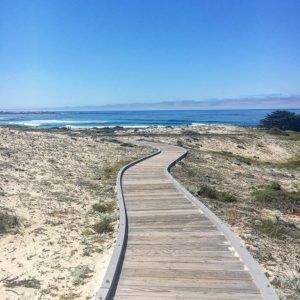In early March, many of our members attended the our regional SCBWI conference at Asilomar conference center near Monterey, CA. In addition to a windswept beach for inspirational walks, the conference offered an amazing faculty as well as time to hang out with other writers in person.
The theme was Find the Heart In Your Story. Within that theme, the speakers challenged us in our writing in different ways–from practice to practical tips, from craft to marketing, from the emotion of your story to the emotions of the writer’s journey. We’ve compiled some of our insights from the conference for you here. We hope they inspire you!
(This list comes from a Facebook conversation, so you’ll see responses peppered throughout.)
On practicing writing
One takeaway: I don’t need to write every day, I need to practice writing every day. Much of the writing I do won’t be in a draft–it will be background work on character, plot exploration, setting descriptions, or just playing with words that don’t relate to my current works-in-progress. (Inspired by Tricia Lawrence‘s talk on using method acting techniques to explore character.) –Anne-Marie
This is definitely something I’ve discovered about myself. My WIP is always in the back of my mind but trying to write every day is futile and loaded with guilt for me. I do better writing in short concentrated bursts like the two day writing retreat I just gifted to myself or NaNoWriMo. –Jen
Oh man, totally with you on not writing every day. This came up in an interview I just did with a spiritual teacher, and she has a really interesting perspective on balancing goals with, you know, happiness and your original intent. –Juniper
On Plotting
In her talk “Plot Problems? No Problem!” Carrie Howland invited us to dive into the center of our novels to discover where they are failing. If you’re a visual thinker, the node-and-line plot mapping she describes as “radial plotting” can help you literally see how the elements of your story are connected to one another and to your central conflict.
Identify what you believe is the most explosive moment in your novel. On the center of a large blank page, summarize this moment in a short sentence. Draw a circle around it. Now draw more circles around the central circle and link each to the main circle with a line. Think about the “what,” “who,” “why,” “when,” and “how” in your story immediately related to this central conflict and use this information to fill in your empty circles. Be brief. Now take a look at this next ring of circles and ask yourself what precedes each of these moments. Continue this way, noting each important “what,” “who,” and so on, as you move further away from the novel’s central conflict. Be organic – a “who” moment may follow a “why” moment, which in turn may follow a “what” moment.
 Each string of nodes that results is a trail of breadcrumbs that leads up the story climax. By asking ourselves “how did I get here?” at every juncture of the story, we can see where we have drifted off on plot tangents or find the story mired in extraneous scenes, because in mapping the story backwards, the unnecessary elements won’t (easily) fit into place. Howland suggests you then map out what remains of your novel after the story climax, too.
Each string of nodes that results is a trail of breadcrumbs that leads up the story climax. By asking ourselves “how did I get here?” at every juncture of the story, we can see where we have drifted off on plot tangents or find the story mired in extraneous scenes, because in mapping the story backwards, the unnecessary elements won’t (easily) fit into place. Howland suggests you then map out what remains of your novel after the story climax, too.
As a sidenote, if this visual method of plotting and replotting works for you, I’d highly recommend trying out Scapple, a simple freeform visualization tool from the creators of Scrivener. Scapple lets you create node and peg diagrams linked with lines or arrows, and allows you to rank and sort with a range of font, outline, and color choices. It’s currently about $15. –Brigid
The radial plotting class kicked my butt. In a good way, but still working up the courage to completely dismantle my story and put it back together That was probably my biggest takeaway. –Juniper
On Social Media
One of my many big takeaways was from Evelyn Skye‘s discussion of marketing and social media. I have been thinking a lot about her advice to pick 3 things that you want to be known for or associated with, and return to those 3 topics frequently in your social media feeds. Be strategic in choosing things that your audience can relate to and that relate to your work. (Eveyln’s: her writing, her sweet tooth, and romance/boyfriend — perfect for her YA audience.) It’s easier said than done! –Lauren
Totally agree. I have three things listed on my Twitter profile and, while they’re true, they’re also pretty random. Evelyn’s talk made me realize that even these throwaway representations of ourselves online fit into a bigger picture of who we say we are and what we decide to share. –Brigid
Getting to the Heart of Your Story–3 ways
- Daniel Nayeri‘s point that writers take shortcuts with their stories/characters was mindblowing. He argues that we do so because our computing brains are thrashing–overloaded–and the shortcuts are the only way we can function. So we end up with worlds that don’t extend beyond the page and aren’t fully realized, or characters built on stereotypes. I have spent plenty of time pondering his idea that these shortcuts are a “failure of computational imagination.” Particularly, it’s made me think about my revision process: I might be able to highlight obvious shortcuts (or failures of computational imagination) and then focus all of my somewhat limited computing power on each one separately.
- I loved Molly Burnham‘s insight that “clues to the heart of our story are in our drafts, but it takes an evolution for us to see them.”
- I really took to heart Tricia Lawrence’s challenge to continue a line of questioning with our character (what if questions, interviews) until we reach the character’s core truth or golden rule–that rule the character uses to judge everything they do. (Examples might be: “honesty above all” or “everyone’s out to get me.”) –Kristi
Yes, and all 3 of the things Kristi mentioned totally went together! The theme of the conference was pretty strong – find the heart of your story. It was all about digging deeper in, past the surface representations, until you find “the story only YOU can write.” –Juniper
See Juniper’s full description of her conference experience here: http://www.junipernichols.com/chasing-rainbows/.
What inspiration have you found recently? How have you been challenged in your writing?
Kristi Wright (co-editor) writes picture books and middle grade novels. Her goal as a writer is to give children a sense of wonder, a hopefulness about humanity, and a belief in their future. She is represented by Kurestin Armada at Root Literary. She is an active volunteer for SCBWI and a 12 X 12 member. Find her at www.kristiwrightauthor.com and on Twitter @KristiWrite.


COMMENTs:
0